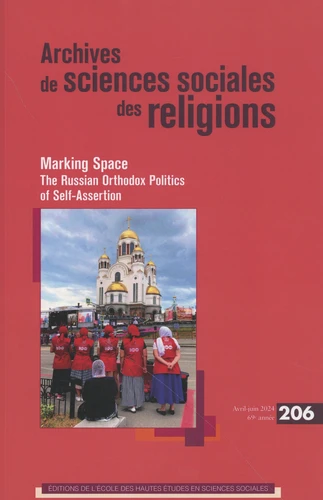Archives de sciences sociales des religions N° 206, avril-juin 2024
Making Space. The Russian Orthodox Politics of Self-Assertion
Par : , Formats :
- Paiement en ligne :
- Livraison à domicile ou en point Mondial Relay dès le 24 juilletCet article sera commandé chez un fournisseur et vous sera envoyé dans les 3 jours après la date de votre commande.
- Retrait Click and Collect en magasin gratuit
- Livraison à domicile ou en point Mondial Relay dès le 24 juillet
- Réservation en ligne avec paiement en magasin :
- Indisponible pour réserver et payer en magasin
- Nombre de pages180
- PrésentationBroché
- FormatGrand Format
- Poids0.294 kg
- Dimensions15,7 cm × 24,0 cm × 1,0 cm
- ISBN978-2-7132-3353-1
- EAN9782713233531
- Date de parution13/09/2024
- ÉditeurEHESS
Résumé
This issue, "Marking Space : the Russian Orthodox Politics of Self-Assertion," delves into the complex interplay between the Russian Orthodox Church and the socio-political landscape in post-Soviet Russia. Despite Orthodoxy becoming the default religion in many parts of Russia after the USSR's collapse, its public presence is still contested in a predominantly secular society. The articles examine the politics of space, focusing on how religious markers such as crosses, frescoes, pilgrimages, buildings, and collective prayers are employed to claim and transform public spaces into political territories and loci of utopia.
This process frequently ignites debates about the common good and the appropriate role of religion in public life. Key themes include issues of heritage and memory, particularly the creation of traditions and the sacralization of places within the vision of a utopian "Holy Russia." The ambivalent relationship between the State and the Church is also explored, characterized by both cooperation and tension as the Church seeks to expand its influence.
Through these discussions, this issue provides a nuanced understanding of the Russian Orthodox Church's efforts to shape spaces and identities in contemporary Russia.
This process frequently ignites debates about the common good and the appropriate role of religion in public life. Key themes include issues of heritage and memory, particularly the creation of traditions and the sacralization of places within the vision of a utopian "Holy Russia." The ambivalent relationship between the State and the Church is also explored, characterized by both cooperation and tension as the Church seeks to expand its influence.
Through these discussions, this issue provides a nuanced understanding of the Russian Orthodox Church's efforts to shape spaces and identities in contemporary Russia.
This issue, "Marking Space : the Russian Orthodox Politics of Self-Assertion," delves into the complex interplay between the Russian Orthodox Church and the socio-political landscape in post-Soviet Russia. Despite Orthodoxy becoming the default religion in many parts of Russia after the USSR's collapse, its public presence is still contested in a predominantly secular society. The articles examine the politics of space, focusing on how religious markers such as crosses, frescoes, pilgrimages, buildings, and collective prayers are employed to claim and transform public spaces into political territories and loci of utopia.
This process frequently ignites debates about the common good and the appropriate role of religion in public life. Key themes include issues of heritage and memory, particularly the creation of traditions and the sacralization of places within the vision of a utopian "Holy Russia." The ambivalent relationship between the State and the Church is also explored, characterized by both cooperation and tension as the Church seeks to expand its influence.
Through these discussions, this issue provides a nuanced understanding of the Russian Orthodox Church's efforts to shape spaces and identities in contemporary Russia.
This process frequently ignites debates about the common good and the appropriate role of religion in public life. Key themes include issues of heritage and memory, particularly the creation of traditions and the sacralization of places within the vision of a utopian "Holy Russia." The ambivalent relationship between the State and the Church is also explored, characterized by both cooperation and tension as the Church seeks to expand its influence.
Through these discussions, this issue provides a nuanced understanding of the Russian Orthodox Church's efforts to shape spaces and identities in contemporary Russia.


